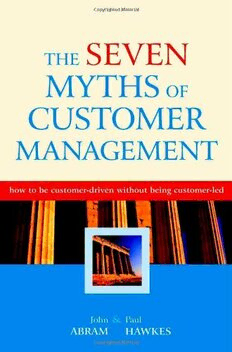Table Of ContentTHE SEVEN MYTHS OF
CUSTOMER MANAGEMENT
How to be customer-driven without
being customer-led
John Abram
Paul Hawkes
JOHN WILEY & SONS, LTD
THE SEVEN MYTHS OF
CUSTOMER MANAGEMENT
THE SEVEN MYTHS OF
CUSTOMER MANAGEMENT
How to be customer-driven without
being customer-led
John Abram
Paul Hawkes
JOHN WILEY & SONS, LTD
Copyright © 2003 John Wiley & Sons Ltd, The Atrium, Southern Gate, Chichester, West
Sussex PO19 8SQ, England
Telephone (+44) 1243 779777
Email (for orders and customer service enquiries): [email protected]
Visit our Home Page on www.wileyeurope.com or www.wiley.com
All Rights Reserved. No part of this publication may be reproduced, stored in a retrieval
system or transmitted in any form or by any means, electronic, mechanical, photocopying,
recording, scanning or otherwise, except under the terms of the Copyright, Designs and
Patents Act 1988 or under the terms of a licence issued by the Copyright Licensing Agency
Ltd, 90 Tottenham Court Road, London W1T 4LP, UK, without the permission in writing of
the Publisher. Requests to the Publisher should be addressed to the Permissions Depart-
ment, John Wiley & Sons Ltd, The Atrium, Southern Gate, Chichester, West Sussex PO19
8SQ, England, or emailed to [email protected], or faxed to (+44) 1243 770620.
This publication is designed to provide accurate and authoritative information in regard to
the subject matter covered. It is sold on the understanding that the Publisher is not engaged
in rendering professional services. If professional advice or other expert assistance is
required, the services of a competent professional should be sought.
Other Wiley Editorial Offices
John Wiley & Sons Inc., 111 River Street, Hoboken, NJ 07030, USA
Jossey-Bass, 989 Market Street, San Francisco, CA94103-1741, USA
Wiley-VCH Verlag GmbH, Boschstr. 12, D-69469 Weinheim, Germany
John Wiley & Sons Australia Ltd, 33 Park Road, Milton, Queensland 4064, Australia
John Wiley & Sons (Asia) Pte Ltd, 2 Clementi Loop #02-01, Jin Xing Distripark, Singapore
129809
John Wiley & Sons Canada Ltd, 22 Worcester Road, Etobicoke, Ontario, Canada M9W 1L1
Wiley also publishes its books in a variety of electronic formats. Some content that appears
in print may not be available in electronic books.
Library of Congress Cataloging-in-Publication Data
Hawkes, Paul.
The seven myths of customer management: how to be customer-driven without being
customer-led / Paul Hawkes, John Abram.
p. cm.
Includes bibliographical references and index.
ISBN 0-470-85880-X (cloth : alk. paper)
1. Customer relations – Management. I. Abram, John. II. Title.
HF5415.5.H375 2003
658.8¢12 – dc21 2003007516
British Library Cataloguing in Publication Data
Acatalogue record for this book is available from the British Library
ISBN 0-470-85880-X
Typeset in 11/14 Palatino by SNPBest-set Typesetter Ltd., Hong Kong
Printed and bound in Great Britain by TJ International Ltd, Padstow, Cornwall
This book is printed on acid-free paper responsibly manufactured from sustainable forestry
in which at least two trees are planted for each one used for paper production.
Contents
Figures ix
Acknowledgements xi
Introduction xii
1 The seven myths of customer management:
Debunking some established wisdom 1
The dangers of customer leadership 1
What is really happening? 5
Myth 1: Customer retention is the key to increased
profitability 6
Myth 2: Divesting unprofitable customers will increase
profitability overall 9
Myth 3: Customer satisfaction leads to customer loyalty 12
Myth 4: Repeat purchase is the same as customer loyalty 15
Myth 5: Organizations should develop relationships
with their customers 18
Myth 6: One-to-one marketing is the ultimate goal 21
Myth 7: Technology is the primary enabler of customer
focus 25
Adifferent approach 28
vi Contents
2 Testing the water: Understanding where you are today 29
Picking up customer signals 32
Business-to-business customers 36
What research does not tell you 39
New technology, new danger 42
Substituting benchmarking for thought 44
Ten ways to gain real customer insight 46
3 Look before you leap: Developing a customer-focused
strategy 50
What is customer-focused strategy? 52
Strategy in context 55
Developing customer-focused strategy 58
Appraising the world outside 62
Seeking to be different 66
Leading on cost 69
Focusing on markets or customers 70
The customer lifecycle 73
Deciding and evaluating alternatives 77
Action planning 80
4 Measuring your way to success: Allocating resources
for maximum effect 83
The failure of measurement 85
Customer attitude measures 86
Customer retention measures 87
Customer value measures 89
The failure of management information systems 93
Towards customer value 97
Customer value analysis in action 102
The pitfalls and problems 107
The benefits of value-based management 109
5 Don’t keep it too simple, stupid: The need for a
segmented approach 111
Segment or die 113
Understanding customers’ needs and motivations 114
Contents vii
Collecting the data 120
From data to intelligence 120
From intelligence to hypothesis 126
From hypothesis to appraisal 130
From appraisal to strategy 131
From strategy to results 133
Pitfalls and problems 136
Segmentation: a postscript 138
6 Lining up the ducks: Aligning the company for
customer focus 140
Aligning finance 142
Aligning product strategy 143
Aligning the proposition: from product to profit 146
Brand alignment 148
Aligning distribution 150
Aligning customer communication 152
Loyalty programmes 158
Alignment: a postscript 163
7 Are you the problem? The role of leadership in
creating customer focus 164
Data-less decision making 166
Rearranging the deckchairs 168
The pitfalls of project teams 169
Best practice is sometimes best left alone 170
Incentivizing inappropriate behaviour 172
Technology turmoil 175
Everyone embraces change enthusiastically 179
Reorganizing for focus 183
Changing a light bulb 187
8 Bringing the focus alive: Apractical action plan 188
An action plan for customer focus 190
Managing the customer focus process 190
The internal review 193
viii Contents
Customer dynamics and needs 195
Segment objectives and propositions 198
Customer-management objectives, strategy and tactics 200
Channel strategies and implementation 207
Testing and performance measurement 208
Customer and market knowledge management 211
Change planning 213
Technology strategy 214
Index 218

